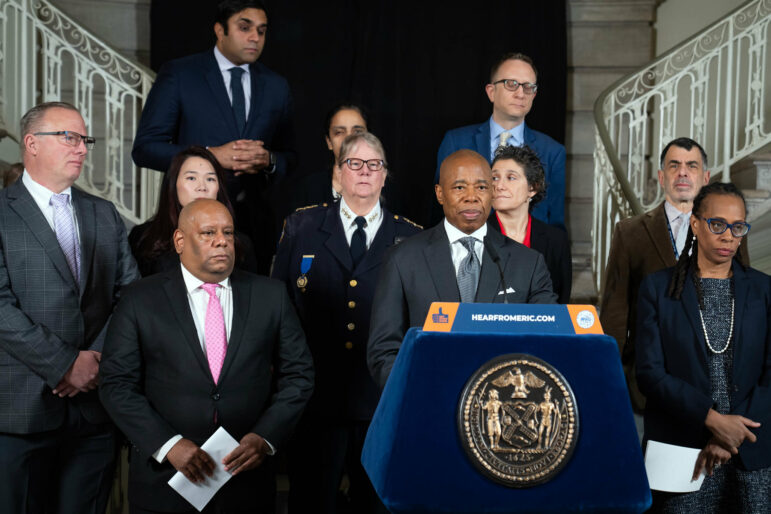
Initial Data on Forced Removals of People Deemed Mentally Ill Spurs Demand for Details
“Every time you try to look at a piece of what’s being said here, it opens up a Pandora’s box of questions,” said Beth Haroules, director of disability justice litigation at the New York Civil Liberties Union.
Ed Reed/Mayoral Photography Office.
Mayor Eric Adams provides an update on the city’s “severe mental illness plan” at City Hall Wednesday.
A controversial initiative to involuntarily remove people from public spaces for a hospital evaluation has landed at least a few dozen people in a shelter or apartment, city officials said Wednesday, though reporting on removal outcomes is not comprehensive.
Speaking from the City Hall rotunda, Mayor Eric Adams celebrated that 54 people on a city-managed short list are now off of the streets—a share of whom experienced involuntary hospitalization—one year after he announced a plan targeting street homeless New Yorkers with severe mental illness.
“One year later, we are proud to stand here and say early results show our plan is working,” Adams told reporters. “We have housed and helped a significant number of those most in need of care and support.”
All 54 people had been on one of two “Top 50” lists maintained by the city’s Coordinated Behavioral Health Task Force, which works with nonprofit homeless outreach teams to identify and track particularly high-need street homeless New Yorkers.
Of the total, 23 entered the shelter system voluntarily, according to Brian Stettin, City Hall’s senior advisor on severe mental illness. The remaining 31 were initially hospitalized.
“Sometimes this person had a medical need that had to be addressed that they recognized and came in voluntarily, but most of those 31 did come in through involuntary hospitalization,” Stettin told City Limits.
Yet this group appears to be a small share of the total universe of New Yorkers being forcibly removed from public spaces and taken to a hospital—a tactic the administration described as a “last resort” in Tuesday’s press release. Since May, according to Stettin, there have been an average of 137 involuntary removals each week.
“We took that taboo away,” Adams told reporters Wednesday. “We said there’s nothing wrong if you see someone with severe mental health illness, unable to take care of themselves, a danger to themselves and others, you can take that action and you will not be penalized for taking that action.”
The police department did not report these removals prior to the Adams administration, according to City Hall, making comparisons over time difficult.
City Hall also did not share how many of these weekly removals are a single individual being hospitalized multiple times. “That kind of refinement of the data is an ongoing process,” Stettin said.
Brooklyn Council Member Sandy Nurse, who sponsors legislation that would require more comprehensive reporting on removals and homeless encampment sweeps, drilled down on this murkiness.
“It’s unclear how many people in these removals are folks who are being repeatedly removed over and over again,” she said. “And I think having more tracking and data on this, from the initiation process all the way through to the outcome, would be incredibly helpful for us to determine if this is a strategy that works.”
As part of his November 2022 initiative, Mayor Adams issued a directive ordering the police department, emergency medical services and Department of Health and Mental Hygiene (DOHMH) to take an expansive view of state law that allows for “involuntary removal” of people, even if a person does not present an immediate threat to others.
Under the directive, a person can be detained for evaluation and transported to a hospital if they decline assistance and “it appears that they are suffering from mental illness and are a danger to themselves due to an inability to meet their basic needs.”
“The thing that we’ve kind of really done differently this year is we’re really leaning into this notion where a person’s failure to meet their basic human needs as being grounds to say that they are a danger to themselves,” Stettin told City Limits.
He went on to describe the types of conversations among members of the Coordinated Behavioral Health Task Force that could lead to an involuntary removal.
“It gives us the opportunity to have discussions about what this person’s current condition is, how they’re presenting, some medical need they’re kind of neglecting that’s going to become a problem over time,” he said. “Maybe they’re unusually dirty or have lice or are emaciated. These are things that we’re talking about, and we’re actually making decisions, ‘Yeah we think we have enough grounds to bring this person in.’”
Where that person ends up after their hospital stay—in a stable home, or back on the streets—is crucial information that must be fleshed out in more detail, according to advocates for the homeless.
At Wednesday’s press conference, City Hall touted that about 1,000 people moved out of low-barrier shelter beds and into apartments in the year that ended this June, more than twice as many as the year prior.
But the city did not provide data on the outcomes for the entire population of New Yorkers removed to hospitals in the last year. And data on the 54 people highlighted Wednesday lacks granularity.
Of that population, 14 are currently hospitalized. The other 40 are either in low-barrier shelter beds or nursing homes, have moved back in with family, or have been placed in supportive housing—low-cost apartments with accompanying services including mental healthcare. A City Hall spokesperson did not provide a more detailed breakdown.
“It’s notable that the city fails to provide data on how many of those who were subject to involuntary removals actually ended up getting the services and housing they truly need,” said Dave Giffen, executive director of Coalition for the Homeless, in a statement.
Meanwhile, recent data obtained by MFJ Legal Services through a records request suggests that there are thousands of empty supportive housing units in the city.
As of Sept. 15 there were 1,831 vacant units available to rent, and another 2,083 categorized as vacant and “offline.” Another 377 new apartments were awaiting certificates of occupancy, and 291 were linked with a tenant yet to move in.
“We have both a lack of housing opportunities for people who need it, and a lot of vacant, warehoused settings that are being underutilized completely,” said Beth Haroules, director of disability justice litigation at the New York Civil Liberties Union.
There needs to be more transparency around the entire involuntary removal process, she added.
“Every time you try to look at a piece of what’s being said here, it opens up a Pandora’s box of questions,” Haroules said. “If they’re really doing right by people, then they really need to be forthcoming.”
To reach the reporter behind this story, contact Emma@citylimits.org. To reach the editor, contact Jeanmarie@citylimits.org.
The post Initial Data on Forced Removals of People Deemed Mentally Ill Spurs Demand for Details appeared first on City Limits.


